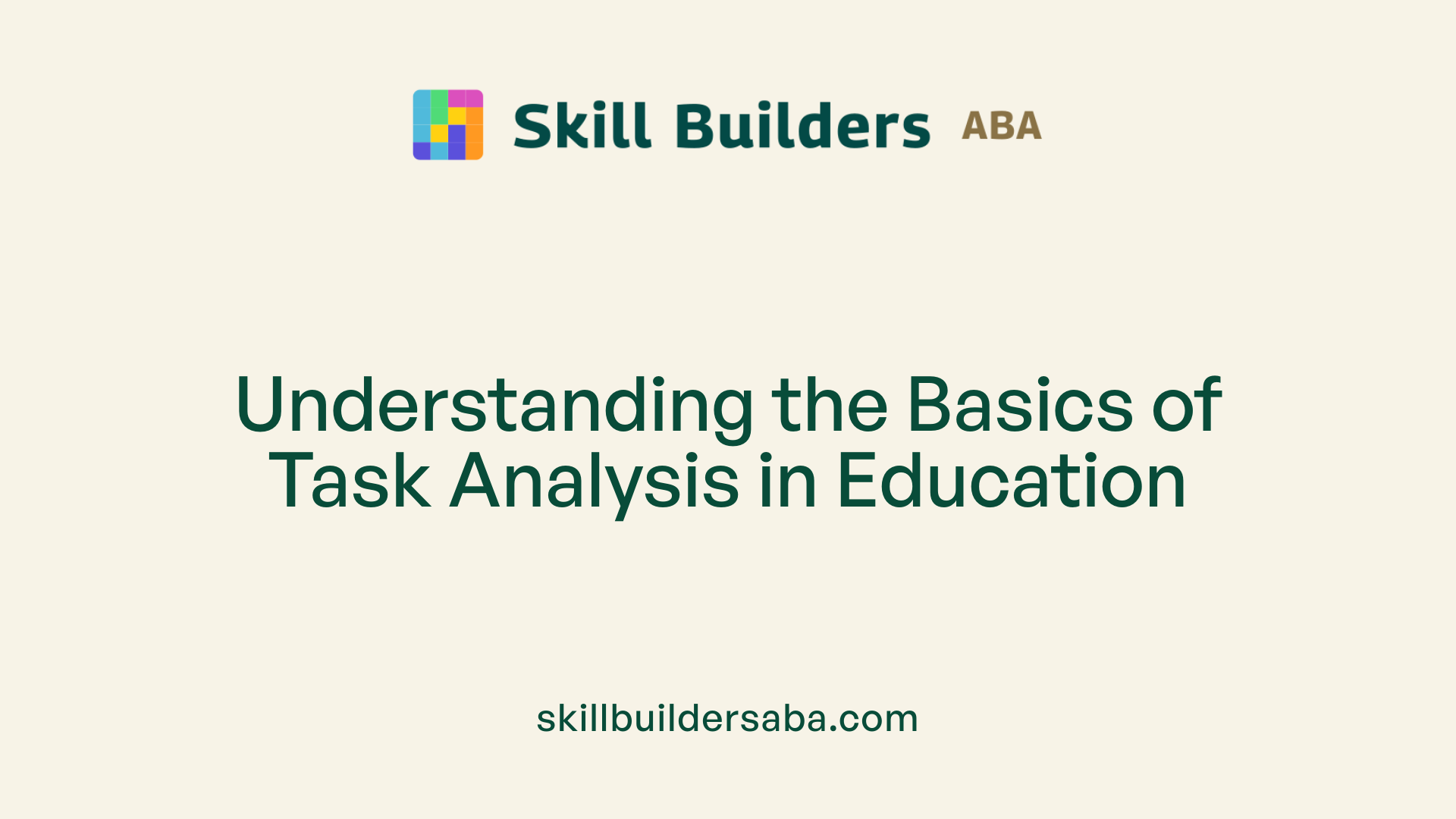
Using task analysis to teach complex skills
Unlocking Complex Skills Through Structured Learning
Building Independence with Systematic Teaching Strategies
Task analysis is a proven, evidence-based method used to facilitate the teaching of complex skills by breaking them down into smaller, manageable steps. This approach is especially critical in special education, where individuals, including those on the autism spectrum, often require clear, structured guidance to develop independence in daily activities, academic tasks, and social behaviors. By systematically deconstructing skills, educators and therapists can craft tailored instructional plans that promote mastery, confidence, and functional independence.
Fundamentals of Task Analysis in Education

What is a task analysis and how does it support learning?
A task analysis is a systematic process used to break down complex skills or tasks into smaller, manageable steps. This approach helps educators and caregivers teach skills more effectively, especially for children with autism or other special needs. By dividing a skill into simple parts, learners can focus on mastering each step before advancing to the next, which boosts confidence and encourages independence.
How can task analysis be used to teach complex skills?
Task analysis is an evidence-based tool that facilitates the teaching of complex behaviors like self-help, social skills, or academic activities. The process begins by selecting the skill to teach and then carefully observing or consulting experts to identify each component step. The steps are operationally defined—meaning they're clear, specific, and observable—so that learners with different abilities can understand them.
Educators often verify the sequence by practicing or reviewing with colleagues. Once the steps are laid out, different teaching methods such as forward chaining (teaching from the first step onward), backward chaining (starting from the final step), or total task teaching (covering all steps at once) are used to teach the skill.
Monitoring progress with data collection—whether visual charts or checklists—helps track mastery and guides instruction. As students demonstrate proficiency, the skill can be generalized across settings and contexts, leading to greater independence.
What are the steps involved in identifying and developing a task analysis?
Developing a task analysis involves several steps:
- Observation and Selection: Watch the individual perform the skill or perform the skill yourself to understand all components.
- Breaking Down the Skill: Divide the task into sequential steps, ensuring each one is clear and precise.
- Operational Definition: Define steps in simple, literal terms—particularly important for students with autism who may interpret instructions literally.
- Verification and Adjustment: Test the steps with the learner and adjust based on their responses.
- Creating Support Materials: Use visuals, written instructions, or photographs to support understanding.
Factors influencing individualization in task analysis
Every learner is unique, so task analyses should be tailored accordingly. Factors to consider include:
- Age and developmental level
- Communication and processing abilities
- Prior experiences and familiarity with the task
- Individual preferences and interests
This individualization ensures that tasks are both accessible and motivating, which increases the likelihood of success.
Additional tools and methods
Besides breaking down skills, educators may use chaining procedures—forward, backward, or total task—depending on what best fits the learner. Consistent data collection helps measure progress, refine strategies, and ensure that each step promotes mastery.
| Aspect | Method or Technique | Description |
|---|---|---|
| Approach | Forward Chaining | Teach steps from the beginning to the end sequentially |
| Approach | Backward Chaining | Focus on mastering the last step first, then previous steps |
| Approach | Total Task Teaching | Teach all steps in sequence, often simultaneously |
Research and practice confirm that task analysis is a foundational method in special education, providing structure and clarity that greatly enhance the teaching of complex skills.
Applying Task Analysis to Life Skills and Behaviors

How is task analysis applied to teaching life skills and complex behaviors?
Task analysis is a structured approach that helps teach complex skills by breaking them into smaller, manageable steps. This method makes it easier for individuals, especially those with autism spectrum disorder (ASD), to learn and perform multi-step activities independently.
In teaching daily living skills like brushing teeth, washing hands, or dressing, educators and caregivers develop a step-by-step sequence. Each step is clearly defined and taught sequentially. Techniques such as forward chaining, where the first step is mastered before moving to the next, and backward chaining, which focuses on the final step first, are frequently used. Visual supports like pictures or written instructions further assist understanding.
Task analysis isn’t limited to daily routines. It’s also effective in teaching academic and social skills. For example, a social story or a structured sequence can help children learn how to initiate conversations or participate in classroom activities.
Monitoring progress is essential. Data collection methods, like single-opportunity and multiple-opportunity assessments, track whether students complete each step independently or require support. This data guides educators to adjust strategies, ensuring that each learner progresses at an appropriate pace.
Furthermore, applying this approach nurtures increased independence, confidence, and skill mastery. Whether in the context of self-care, academic routines, or social interactions, task analysis provides a clear roadmap for teaching complex behaviors effectively.
Teaching Methods and Chaining Techniques in Practice

What are the methods of teaching complex skills with task analysis in ABA therapy?
In Applied Behavior Analysis (ABA), several structured methods are used to teach multi-step or complex skills through task analysis. The most common are forward chaining, backward chaining, and total task teaching.
Forward chaining begins with the first step of the task, teaching it thoroughly before moving on to the next. This method ensures that the learner masters initial steps early, building confidence and foundational skills.
Backward chaining, on the other hand, starts with the last step of the task. This approach allows the learner to complete the entire process independently, which can be very motivating and helps solidify the final outcome.
Total task teaching involves introducing all steps of the skill at once, teaching and prompting as needed until the whole task is performed correctly. This method is especially useful when the learner's ability fits with processing the entire sequence, or when working on specific steps within a broader activity.
What are the types of task analysis used in autism support?
In autism support, different types of task analysis are tailored to individual needs and specific contexts. These include:
- Forward chaining: Teaching skills step-by-step from the beginning, excellent for establishing foundational routines.
- Backward chaining: Focusing on the last step first, helping learners experience success with complete tasks.
- Total task teaching: Addressing all steps simultaneously, ideal when the individual can handle multiple steps or needs comprehensive skill acquisition.
- Natural Environment Teaching (NET): Embedding skills into daily routines and natural settings, which promotes adaptability and generalization.
- General task analysis: Breaking complex skills into manageable, sequential steps, often incorporating prompts, shaping, and chaining to support learning.
These methods help create accessible, engaging, and adaptable learning experiences that support skill development in individuals with autism.
Implementing chaining techniques successfully
Effective implementation of chaining techniques requires careful planning and data collection. Instruction should be individualized, considering the learner's skills, preferences, and needs.
Using prompting and fading strategies helps gradually transfer independence from physical or verbal prompts to spontaneous performance.
Consistent data collection methods, like single-opportunity or multiple-opportunity procedures, are essential to track progress, identify mastery, and inform instructional adjustments.
Incorporating visuals or written instructions can also aid understanding, especially for learners who interpret tasks literally. Regularly reviewing and modifying the step sequence ensures the teaching remains effective and responsive.
Overall, careful application of these methods supports learners in acquiring complex skills systematically, fostering independence across daily routines and tasks.
Resources, Case Studies, and Practical Applications

Are there resources or case studies demonstrating the application of task analysis?
Yes, there are numerous resources and case studies that demonstrate how task analysis can be effectively used in various settings. For instance, six single-case design studies have shown its success in improving outcomes for learners with autism spectrum disorder (ASD). These studies help validate the approach and provide evidence for its effectiveness.
Many educational websites, instructional guides, and professional development materials include step-by-step procedures, checklists, and data collection tools. These resources are designed to help teachers, therapists, and parents implement task analysis accurately and confidently.
Research also highlights that task analysis is versatile, being used across different environments such as home, school, and therapy clinics. Its application spans teaching daily living skills, social skills, academic tasks, and desensitization programs.
By leveraging these resources, professionals and caregivers can tailor individual plans suited to each child's abilities, ensuring more successful skill acquisition and independence.
Examples of task analysis in educational settings
In schools, task analysis is often used to teach routines like handwashing or opening a lunchbox. For example, a teacher might develop a step-by-step procedure that includes:
- Turning on the tap
- Wetting hands
- Applying soap
- Scrubbing for 20 seconds
- Rinsing
- Drying with a towel
Visual supports such as pictures or photographs accompany each step, which helps children with autism interpret and follow the instructions more easily.
Similarly, task analysis supports teaching behaviors in social skills, like greeting peers or participating in classroom routines, by breaking these activities into manageable parts.
Use of visuals and prompts
Using visuals such as pictures, photographs, or written instructions enhances the effectiveness of task analysis. These visual aids are especially helpful for children with communication challenges or those who interpret language literally.
Prompts can include physical guidance, verbal cues, or visual reminders, which fade over time as independence improves. Incorporating a variety of prompts aligns with the individual child's learning style and needs, promoting successful skill mastery.
| Resources & Case Studies | Focus Area | Description | |------------------------|--------------|--------------| | Single-Case Design Studies | Research Evidence | Six studies demonstrating effectiveness in ASD | | | Instructional Guides | Practical Use | Step-by-step procedures and checklists | | | Visual Supports | Teaching Strategies | Photographs, pictures, and prompts for clarity | | | Data Collection Tools | Progress Monitoring | Protocols for tracking mastery and independence | |
These tools and examples show the practical value of task analysis in promoting skill development, supporting data-driven instruction, and fostering independence among learners with diverse needs.
Concrete Examples and Practical Tips for Implementation

What are some specific skill breakdowns, such as washing hands or putting on a coat?
Task analysis involves breaking down complex skills into simple, manageable steps to make learning easier. For example, washing hands can be segmented into steps like turning on the tap, applying soap, scrubbing hands, rinsing, and drying. Similarly, putting on a coat might include steps such as grabbing the coat, unzipping or unsnapping, inserting arms into sleeves, and fastening buttons or zipper.
Other daily routines, like brushing teeth, can be broken down into: reaching for the toothbrush and toothpaste, applying toothpaste, brushing thoroughly, rinsing, and cleaning up. Academic tasks, such as solving a math problem, also benefit from step-by-step breakdowns—understanding the question, choosing the operation, performing calculations, and verifying the result. This detailed process helps teachers ensure consistent teaching and helps students with complex learning needs master each part.
How to ensure consistency and support generalization across different settings?
When implementing task analysis, consistency in instruction is essential. Using visual supports like pictures or photographs alongside written instructions can aid understanding, especially for children with autism who tend to interpret instructions literally. Repeating the task across various environments and with different teachers helps promote generalization—the ability to perform the skill in different settings beyond the initial teaching environment.
Regular data collection helps monitor progress and reveals whether students can perform steps independently or still need support. Chaining techniques, such as forward or backward chaining, can be used to teach the entire task gradually, consolidating learning and ensuring skills transfer across contexts.
How is data collection used to monitor progress?
Data collection is a vital part of task analysis. It involves recording whether each step is completed independently, with assistance, or not at all during each trial. Methods like single-opportunity and multiple-opportunity data collection provide insights into a student's mastery level.
Tracking this information enables educators to adjust strategies, decide when to introduce independence, and determine if additional prompting or practice is needed. Consistent documentation supports personalized instruction, helps set realistic goals, and demonstrates student progress effectively.
| Aspect | Description | Examples |
|---|---|---|
| Skill Breakdown | Dividing complex tasks into smaller steps | Washing hands, putting on a coat, brushing teeth |
| Consistency & Generalization | Making sure skills are taught the same way across environments | Visual supports, repeated practice in different settings |
| Progress Monitoring | Recording mastery of steps | Data charts, note-taking on independence levels |
By systematically analyzing tasks, tailoring teaching approaches, and accurately tracking progress, educators can improve learning outcomes for students with diverse needs.
Enhancing Teaching Through Structured Task Decomposition
Using task analysis as a core instructional strategy allows educators and therapists to teach complex skills efficiently and effectively, fostering independence and confidence in learners. By selecting appropriate methods such as chaining, tailoring the analysis to individual needs, and continuously monitoring progress through data collection, practitioners can facilitate meaningful skill acquisition across various settings. Resources, case studies, and practical examples serve as invaluable tools to guide implementation and ensure successful outcomes. Ultimately, structured task analysis empowers learners with the skills necessary for greater independence and improved quality of life.
References
- Applied Behavior Analysis: The Role of Task Analysis and Chaining
- Techniques: Teach Complex Skills to Special Needs Children
- Chaining and Task Analysis [Video] - Relias
- Task Analysis in ABA Therapy: Strategies and Examples
- Using Task Analysis to Teach Daily Living Skills - n2y Blog
- Analysis of Tasks in ABA Therapy: Strategies and Examples
- Applied Behavior Analysis: The Role of Task Analysis and Chaining
- Task Analysis in ABA: Boost Autism Skills | Alpaca Health
- Understanding Natural Environment Teaching in ABA Therapy
A Resource for Your Family
Feel free to check out our website for a comprehensive look at our services. Remember, you don't have to navigate this alone—send us a message if you need personal support.
Reach Out Today
Learn more about how we can support your child’s growth and development. Contact us to discuss our services and availability in your area.
.svg)